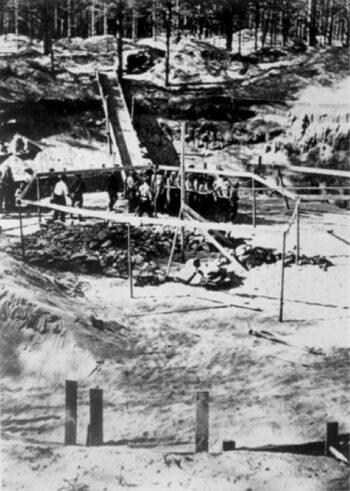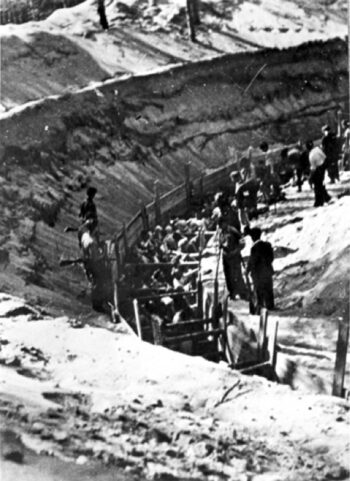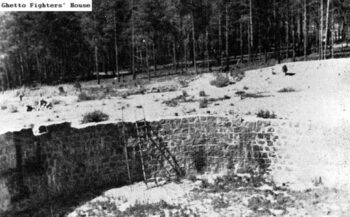Ponary
Ponary is the Polish name for the Lithuanian town Paneriai, which today is a mere district of Lithuanian’s capital Vilnius. Between 1921 and 1939, the town was part of Poland, hence the name. During the two-year occupation by the Soviets from 1939 to 1941, a construction project was initiated in a forest outside of town for several oil-storage tanks. When German forces moved in in June 1941, only several circular pits had been finished, some with concrete or stone sidewalls.
The orthodoxy has it that German forces used these pits as mass graves for murdered Jews from the Vilnius area, and also for Soviet PoWs and Polish civilians. A total of somewhere between 70,000 and 100,000 victims are supposed to have been buried there, most of them Jews. This death toll makes this Holocaust crime scene comparable to Babi Yar outside of Kiev, although it is far less known.
There is only one contemporary witness report about these alleged mass executions: A certain A. Blyazer claimed in 1944 to have survived the shooting by jumping into the pit alive and getting covered by corpses. He later climbed out from beneath layers of bodies. In 1943, he was arrested again and assigned to exhuming and burning the bodies buried in those pits.
No mass shooting at this site is mentioned in the Einsatzgruppen reports. However, German documents report a total of some 24,300 persons killed in the Vilnius area. Furthermore, “several round-shaped burial sites about 30 meters in circumference” located in the Paneriai Forest are mentioned in a 1942 letter of the Healthcare Administration of Vilnius County in response to a request from the local district commissar to list and described the state of all mass graves in the area, as was compulsory throughout the Eastern European territories temporarily occupied by German forces. The letter neither specified the number of graves nor how many victims of which background were buried in them.


There exists moreover a set of photographs of these oil-tank pits showing many dozens, if not hundreds of people herded into them. (See the illustrations.) These photos were evidently taken by Germans or Lithuanian collaborators, who were obviously not prevented from photographing this scene. It is unclear who the people gathered in those pits were and what their fate was, as the photographs do not show any actual shootings or victims of executions. The orthodoxy claims that the persons shown in those photos were Jews about to be executed.
The orthodoxy has it that, within the so-called Aktion 1005, the corpses buried in Paneriai were exhumed and burned on pyres starting in late 1943, and lasting until early July 1944, just before the area was reconquered by the Red Army.
When the Soviets occupied the area in July 1944, a commission of the Red Army inspected the grounds of the alleged burial site. Without any excavations, they asserted already at this point that 100,000 victims had been killed and buried there. A little later, the Soviets formed two investigative commissions, one by the terror organization NKGB, the other by an unspecified Soviet authority. They interviewed several witnesses who claimed to have been involved in the Germans’ attempt at erasing the traces of their claimed crimes. Among these witnesses were most prominently Yuri Farber, A. Blyazer, Matvey Zaydel and Szloma Gol (see their respective entries).
These witnesses claimed to have been forced to exhume and burn between 56,000 and 100,000 bodies from December 1943 or January 1944 until April or May 1944. The cremation technique they described, in particular the size of the pyres they claimed to have built, exposes their tales as physically impossible. The technique becomes feasible only if the claimed size is downgraded by a factor of five or ten, if not more.
The Soviets also conducted some forensic investigations. Five circular pits were excavated, plus one long ditch. All in all, 515 corpses were exhumed and examined. An unspecified amount of ashes and scattered bones were allegedly encountered in the pits and the adjacent forest. From these impressions, the commission extrapolated that “no less than one hundred thousand” had been killed at that site. Photos taken show innocuous circular ditches with stone-lined walls. A few photos show individual corpses or at most a few dozen, but none shows hundreds of them.
Three witnesses claimed to have escaped from the pit they were forced to live in by digging a tunnel through the local sandy soil using their bare hands or with a spoon, propping up the tunnel’s sand walls and roof with wooden posts and boards they made themselves, and lighting the tunnel with electric bulbs, using wires and electricity they got from who-knows where.

In 2016, a team of geological researchers claimed to have located this escape tunnel using ground-penetrating radar and electric resistance measurements. The tunnel is presumably some 35 meters long. (See Fleur 2016.) Excavations were scheduled for later. Such excavations should be less likely to find traces of a tunnel, which would have mostly collapsed and filled with sand over time, but more likely hundreds of wooden poles and boards once used to prop up the tunnel, as the witnesses have claimed. These would have been essential in the loose, sandy soil of that area. Such wooden objects also would have shown up on ground-penetrating radar scans, although they were not mentioned by the researchers. As far as can be established, neither any verifiable data of this research were ever published, nor were any excavations ever undertaken.
If we follow the witnesses’ claims, the Paneriai site would have been smoking continually, day and night, between January and April 1944, if not even until July. Except for a brief claim in one of the Soviet reports that a local resident named Edward Ostrovski saw fire between October 1943 and July 1944, there is no contemporary source verifying that these huge cremations took place: no documents, no photographs, no other testimonies of locals.
(See also the accounts by Yuri Farber, A. Blyazer, Matvey Zaydel and Szloma Gol; for more details, see Mattogno 2022c, pp. 669-694.)

You need to be a registered user, logged into your account, and your comment must comply with our Acceptable Use Policy, for your comment to get published. (Click here to log in or register.)